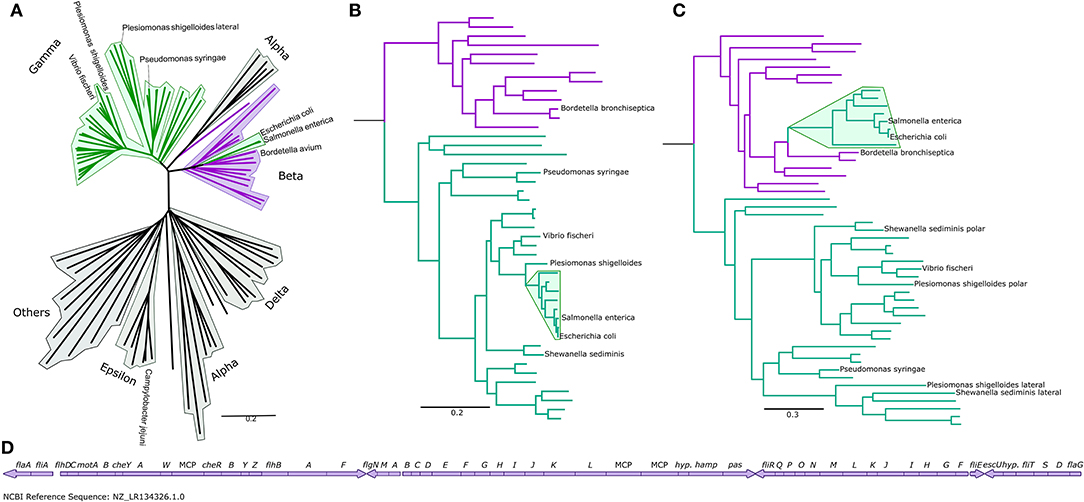The “Jack-of-all-Trades” Flagellum From Salmonella and E. coli Was Horizontally Acquired From an Ancestral β-Proteobacterium
- 1Department of Life Sciences, Imperial College London, London, United Kingdom
- 2Department of Biomedical Informatics, Vanderbilt University Medical Center, Nashville, TN, United States
A Corrigendum on
The “Jack-of-all-Trades” Flagellum From Salmonella and E. coli Was Horizontally Acquired From an Ancestral β-Proteobacterium
by Ferreira, J. L., Coleman, I., Addison, M. L., Zachs, T., Quigley, B. L., Wuichet, K., and Beeby, M. (2021). Front. Microbiol. 12:643180. doi: 10.3389/fmicb.2021.643180
In the original article, there was a mistake in Figure 1 as published. We inadvertently uploaded an outdated version of this figure. The corrected Figure 1 appears below.

Figure 1. The Enterobacteriaceae have β-like motors. (A) An unrooted global flagellar phylogeny. γ-proteobacteria are highlighted in green: the enteric Enterobacteriaceae γ-proteobacteria (Salmonella enterica and Escherichia coli) are not clustered with the other γ-proteobacteria, but are clustered within the β-proteobacteria (purple). Fully annotated version of this tree is presented in Supplementary Figure S1. (B) An organismal phylogeny focused on γ- (green) and β-proteobacteria (purple), rooted with an ε-proteobacterium, Campylobacter jejuni. The Enterobacteriaceae are highlighted in green. Fully annotated version of this tree is presented in Supplementary Figure S4. (C) The flagellar phylogeny of the γ- (green) and β-proteobacteria (purple). Note the shift in position of the Enterobacteriaceae (highlighted in green) from the γ-proteobacterial clade to within the β-proteobacterial clade. Rooted with Campylobacter jejuni. Fully annotated version of this tree is presented in Supplementary Figure S5. (D) The Bordetella bronchiseptica flagellar gene cluster is arranged in one continuous genetic locus.
The authors apologize for this error and state that this does not change the scientific conclusions of the article in any way. The original article has been updated.
Publisher's Note
All claims expressed in this article are solely those of the authors and do not necessarily represent those of their affiliated organizations, or those of the publisher, the editors and the reviewers. Any product that may be evaluated in this article, or claim that may be made by its manufacturer, is not guaranteed or endorsed by the publisher.
Keywords: bacterial flagella, electron cryotomography, molecular evolution, subtomogram averaging, horizontal gene transfer
Citation: Ferreira JL, Coleman I, Addison ML, Zachs T, Quigley BL, Wuichet K and Beeby M (2021) Corrigendum: The “Jack-of-all-Trades” Flagellum From Salmonella and E. coli Was Horizontally Acquired From an Ancestral β-Proteobacterium. Front. Microbiol. 12:773675. doi: 10.3389/fmicb.2021.773675
Received: 10 September 2021; Accepted: 20 September 2021;
Published: 06 October 2021.
Edited and reviewed by: Matt Arthur Baker, University of New South Wales, Australia
Copyright © 2021 Ferreira, Coleman, Addison, Zachs, Quigley, Wuichet and Beeby. This is an open-access article distributed under the terms of the Creative Commons Attribution License (CC BY). The use, distribution or reproduction in other forums is permitted, provided the original author(s) and the copyright owner(s) are credited and that the original publication in this journal is cited, in accordance with accepted academic practice. No use, distribution or reproduction is permitted which does not comply with these terms.
*Correspondence: Morgan Beeby, bWJlZWJ5JiN4MDAwNDA7aW1wZXJpYWwuYWMudWs=
†ORCID: Josie L. Ferreira orcid.org/0000-0002-4411-6131
Izaak Coleman orcid.org/0000-0003-4697-6079
Tobias Zachs orcid.org/0000-0002-0836-0989
Bonnie L. Quigley orcid.org/0000-0003-3787-0993
Morgan Beeby orcid.org/0000-0001-6413-9835
‡Present address: Josie L. Ferreira, Centre for Structural Systems Biology, Heinrich-Pette-Institut, Leibniz-Institut für Experimentelle Virologie, Hamburg, Germany
Izaak Coleman, Department of Systems Biology, Columbia University, Irving Cancer Research Center, New York, NY, United States
Max L. Addison, Warwick Medical School, Microbiology and Infection, University of Warwick, Coventry, United Kingdom
Tobias Zachs, Institute of Molecular Biology and Biophysics, Eidgenössische Technische Hochschule Zürich, Zurich, Switzerland
Bonnie L. Quigley, Provectus Algae Pty Ltd., Noosaville, QLD, Australia
 Josie L. Ferreira
Josie L. Ferreira Izaak Coleman
Izaak Coleman Max L. Addison1‡
Max L. Addison1‡ Tobias Zachs
Tobias Zachs Bonnie L. Quigley
Bonnie L. Quigley Morgan Beeby
Morgan Beeby